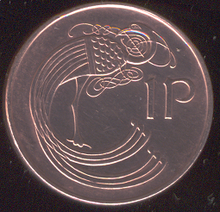Penny (Irish decimal coin)
This article includes a list of general references, but it lacks sufficient corresponding inline citations. (February 2013) |
| Design date | 1971 (first use 1928) |
|---|---|
| Reverse | |
 | |
| Design | Ornamental bird |
| Designer | Gabriel Hayes |
| Design date | 1971 |
The decimal one penny (1p) (Irish: pingin) coin was the second-smallest denomination of the Irish pound. There were 100 pennies (pence) to the pound. The coin was first issued on Decimal Day, 15 February 1971. It was the second of three new designs introduced all in bronze, the others being a half-penny and a two pence coin. All featured ornamental birds designed by Irish artist Gabriel Hayes on the reverse.
The coin originally had a diameter of 2.032 centimetres and mass of 3.564
The coin's official designation was "new penny" and this was changed in 1985 to "penny". In 1990 the decision was taken to produce the coin on a copper-plated steel base as the bronze had become too expensive. The steel base coins are magnetic.
The coin was designed by the Irish artist
In 1990 it was announced that the penny would be redesigned to incorporate the wolfhound design from the pre-decimal sixpence,[1] but this plan was abandoned in the face of the imminent adoption of the euro. The penny was withdrawn with the introduction of euro coins on 1 January 2002.
References
- ^ Cooney, John (20 June 1990). "Lightweight £1 coin to make debut today". The Irish Times. p. 2. Retrieved 8 August 2022.
